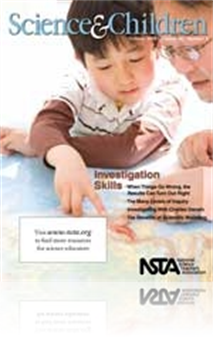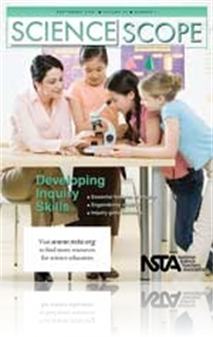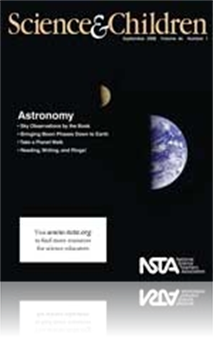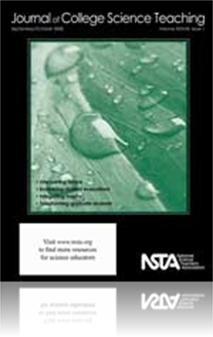All Resources
Journal Article
The Prepared Practitioner: Shedding Light on Misconceptions
This month’s theme is classroom research—a great opportunity to discuss one of the author’s favorite studies, which took place in a single classroom, examining a single teacher, and a single instructional unit. What could one possibly learn fro...
Journal Article
The Early Years: Color Investigations
The topic of color can be a springboard to diverse topics including colors in nature, how vision works, the function of color vision in animals, and the properties of light. Learning about color addresses part of the National Science Education Conten...
Journal Article
Elementary teachers often struggle with how to design and implement inquiry instruction with their students. For many, just understanding what inquiry is can be difficult—let alone designing activities that support high levels of inquiry. In this a...
Journal Article
Editor’s Roundtable: Developing inquiry skills
Inquiry skills cannot be taught in only one grade or taught only at the start of the year; and they cannot be taught by having students memorize a set of procedures and definitions for a pencil-and-paper test on “the scientific method.” To become...
Journal Article
Health Wise: Introducing “Health Wise”
As a science teacher, do you find yourself fielding questions about everything from steroids to skin cancer to the bird flu? Tired of seeing students eat junk food in the school cafeteria? Want to help your students make healthy, informed choices? Th...
Journal Article
Science Sampler: Engendering inquiry
There is a tendency to underestimate the abilities of students to conduct inquiry due to both inferred and actual student restrictions in the traditional school setting. While some constraints exist for viable safety reasons, other constraints placed...
Journal Article
Injecting Inquiry Into Photosynthesis Investigations
This is the story of how a typical middle school lab was transformed into an open-ended inquiry experience through a few small, but very powerful, changes. By allowing students to follow their own questions, the classroom filled with enthusiasm and s...
Journal Article
The Early Years: Thinking Space
Space exploration is a high-interest topic for girls and boys. They love to play with space models (toys), pore over space images, talk about what they have seen in the sky or on television, and play astronaut. Use the activities described here to en...
Journal Article
Teacher’s Toolkit: A blueprint for cultivating inquiry
Scientific inquiry, a methodology that can trace its roots back to the time and teachings of Socrates, has been an elusive and evolving part of our education lexicon for many years. The Socratic approach to teaching, in its simplest form, can be thou...
Journal Article
This study is an analysis of the effectiveness of a faculty-designed laboratory experience about a difficult topic, cellular respiration. The activity involves a hands-on model of the cellular-respiration process, making use of wooden ball-and-stick ...
Journal Article
Guest Editorial: Building Ladders to the Stars
Young children love the stars and planets. They love the idea of leaving the Earth and traveling to the stars, of meeting aliens and exploring unknown worlds. Our goal in elementary school is to build the ladder to the stars and help students up the ...
Journal Article
As instructors of young people, we have come to look beyond unflattering fashions, unfortunate piercings, and unbelievable hair to the people beyond. Misinterpreting a resting face, however, is a more insidious problem because it is essentially autom...
Journal Article
Student Evaluations That Generate More Questions Than Answers
As a chemical educator, one of the author’s primary goals is to provide students with tools for effective learning, hopefully doing so in an engaging, motivating, and incrementally challenging experience. In her quest to figure out how to do a bett...
Journal Article
Tried and True: Helicopter seeds and hypotheses … that’s funny!
Investigating maple samaras, or helicopter seeds, can give students a “that’s funny” experience and catalyze the development of inquiry skills. In this article, the authors describe how to use maple helicopter seeds (samaras) to engage students...
Journal Article
Reading, Writing, and Rings! was created by a team of elementary teachers, literacy experts, and scientists in order to integrate science and literacy. These free units bring students inside NASA’s Cassini-Huygens mission to Saturn. The authors—a...
Journal Article
The West Point Bridge Design (WPBD) building project engages students in project-based learning by giving them a real-life problem to solve. By using technology, students are able to become involved in solving problems that they normally would not en...
Journal Article
Space Week focuses on concepts that enable students to make concrete observations in the early grades (K—2) and move to concepts that help students develop their internet research and writing skills in middle and upper grades (Grades 3—5), and cu...
Journal Article
Bringing Moon Phases Down to Earth
Teaching astronomy concepts to elementary students does not have to be complicated or require expensive materials. As a teacher resource agent for the American Astronomical Society and through involvement with other science- or astronomy-related orga...
Journal Article
Developing the Essential Features of Inquiry
This lesson can be used at the beginning of the year to teach students how to conduct inquiries using the essential features described in Inquiry and the National Science Education Standards (NRC 1996). The lesson is divided into several activities w...
Journal Article
Science Sampler: How many lefties in our classroom?
Probability sampling is an interdisciplinary math and science skill that often serves as the precursor to conducting scientific research. This article describes a lesson that uses probability sampling to allow middle school students to investigate so...
Journal Article
Science Shorts: Here Comes the Sun
Time is an abstract concept for many elementary students. Add to that the idea that the position of the objects in the sky—Sun, Moon, etc.—changes over the course of the day, and you have a mix ripe for confusion and potential misconceptions. In ...
Journal Article
Science 101: An Integrated, Inquiry-Oriented Science Course for Education Majors
Science 101 was designed by a multidisciplinary, multi-institutional team, with leadership from the Departments of Biology and Teacher Education, and participation by faculty in the Departments of Chemistry, Physics, and Mathematics, the College of E...
Journal Article
Science 101: How do we know the universe is expanding, and what exactly does that mean?
Unless you’ve been hiding out in a cave for the last 20 years, you’ve heard that the universe is expanding and it started with a big bang. To put an expanding universe in perspective, it helps to imagine that you live in a two-dimensional univers...
Journal Article
Commentary: The Underlying Life Lesson
Are you, as a science teacher, ever left exhausted at the end of the day wondering, “Is it really worth the effort?” After over 50 years on this Earth—the author can safely say yes, it is. However, he is not a science teacher, and this is not a...
Journal Article
Ask five-year-olds what they want to be when they grow up and we may hear “astronaut,” “dinosaur paleontologist,” or even “princess.” Rather than repeat all of the more realistic professions surrounding them, they go with jobs that captur...
Journal Article
Bernoulli’s Principle: Science as a Human Endeavor
What do the ideas of Daniel Bernoulli—an 18th-century Swiss mathematician, physicist, natural scientist, and professor—and your students’ next landing of the space shuttle via computer simulation have in common? Because of his contribution, ref...
Journal Article
Transforming the Teaching of Science Graduate Students Through Reflection
This paper presents an assessment of a biology education seminar for science graduate students. It describes how this seminar emphasized pedagogy and reflective assignments to help students identify and explore novel instructional strategies, discove...
Journal Article
Tips for the Traveling Teacher
While the ideal situation is for all science to be taught in a properly-equipped classroom, where materials do not have to be transported from room to room, the unfortunate reality is that some teachers do have to travel. As a traveling teacher, the ...
Journal Article
Earth Science Week (ESW) 2008 encourages people around the globe to open doors and investigate new opportunities. This year’s theme, “No Child Left Inside,” is a call to explore our natural environments. The celebration urges everyone—especia...
Journal Article
Science Sampler: Caution! Scientists in the making
Equipping students with knowledge, skills, attitudes, and habits of mind necessary to design investigative questions is an essential goal for any science teacher. Just as with anything new, when students begin to design investigative questions, they ...
Journal Article
Whole-Class Inquiry Assessments
Whole-class inquiry (WCI) assessments range from challenging, paper-and-pencil puzzles to lab-based problems that require students to apply their own gathered data to a new scenario; the latter might also require students to perform a lab with new pa...
Journal Article
Safer Science: Tools for Schools Rules!
In 1995, the U.S. Environmental Protection Agency (EPA) released the highly successful Indoor Air Quality (IAQ) Tools for Schools (TfS) program. The TfS program is an in-the-trenches approach that empowers teachers and other school employees to help ...









